Archive for the ‘Uncategorized’ Category
Yellow Squash Casserole
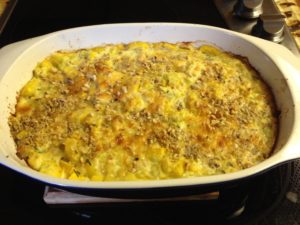
Yellow Squash Casserole
I haven’t eaten yellow (aka Crookneck) squash in a long time. This year I decided to grow one plant, along with my Zucchini. Found some recipes and this was our favorite by far. We’ve made this a number of times and it’s always a hit.
I will grow two plants next year. 🙂
Ingredients:
1 tablespoon organic olive or coconut oil
1 teaspoon organic pastured butter
1 small organic onion, chopped
2 cloves organic garlic, minced
4-6 cups organic yellow squash, cubed
1 teaspoon Celtic Sea Salt
½ teaspoon organic freshly ground black pepper
1/3 cup Almond Flour (or almond meal would work too)
1 cup shredded organic cheese – I’ve used cheddar, Swiss or Monterey Jack – they’re all good.
½ organic heavy cream
2 organic pastured eggs
1/3 cup chopped roasted salted almonds (I’ve used other roasted/ salted nuts successfully too)
Directions:
Preheat over to 400° F
Heat oil and butter in a skillet over medium high heat. When the butter melts, cook and stir onion and garlic until softened, about three minutes. Add squash, salt and pepper. Stir, and cover pan. Let cook, stirring occasionally until the squash is softened, about 5 minutes.
Put squash mixture into a 8×10 or 9 x 13 inch pan.
In a separate bowl, mix almond flour and ½ cup of the grated cheese together and stir into the squash mixture. In another bowl whisk cream and eggs together and stir into squash mix. Top with remaining cheese.
Bake until golden brown and bubbling, 25 to 30 minutes. Enjoy!
Zucchini ‘Spaghetti’
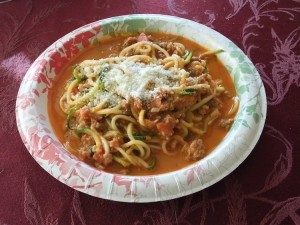
I bought a spiral vegetable slicer a few years back and haven’t had the right occasion to try it out. This year are garden is growing giant zucchini’s so I decided to pull it out and make ‘spaghetti’ with our zucchini. It was great!
I’ll put a link below to the slicer I used. It was SO easy and made long wonderful strands from the zucchini.
This is a pretty free form recipe. You can use any kind of sauce and or meat that you’d like. It would be great with Pesto as well.
Ingredients (for the recipe pictured)
1 pound organic hot Italian pork sausage (ground – you could use ground beef, or lamb too)
1 large organic zucchini (it was really big! – I’m guessing at least 2-3 pounds)
1 jar of organic spaghetti sauce any type.
Directions:
Brown sausage in a pan until cooked through. Add sauce and simmer for a few minutes. Add Zucchini noodles and simmer for 2-3 minutes. Sprinkle with Parmesan cheese if desired and enjoy! (Serves 4-6)
Here’s the link for the one I used.
Gluten Free Zucchini Bread
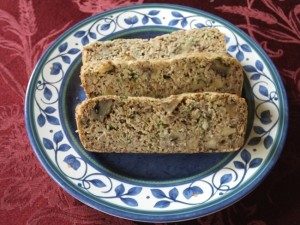
We have one zucchini plant that is producing like crazy already. I am looking for and trying out many new recipes for zucchini and sharing the crop as well! This was really delicious and I will make and freeze some loaves for winter and potlucks.
3/4 cup almond flour, organic if possible (homemade works well)
1/4 cup plus 2 tablespoons organic flax meal
1 1/2 teaspoons organic cinnamon (I’ve been using Ceylon lately)
1 teaspoon baking soda
1/8 teaspoon baking powder
1/2 teaspoon Celtic sea salt
½ to 2/3 cup organic sugar or equivalent (stevia, erythritol, etc)
3 organic pastured eggs
¼ cup organic coconut oil, melted
1 1/2 teaspoon organic vanilla
1 packed cup grated organic zucchini
1/2 cup chopped organic walnuts
Preheat oven to 350 degrees. Line a bread pan with parchment paper.
In a small bowl stir together the dry ingredients. In another bowl use a fork to beat together the wet ingredients until well blended. Mix dry and wet ingredients together.
Stir in the zucchini, then the walnuts (you could also use raisins). Spread in the pan and bake 40 to 45 minutes until the center is set. Remove from pan immediately and let cool completely before slicing with a serrated knife. Freezes well. Enjoy!
Read more great, Fat Tuesday posts here: http://realfoodforager.com/fat-tuesday-july-15-2014/
Read more great, Real Food Wednesday posts here: http://kellythekitchenkop.com/real-food-wednesday-7162014.html
Easy Chicken Tikka Masala
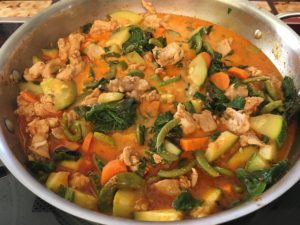
Chicken Tikka Masala
I have been making versions of this for months now. Sometimes with chicken, sometimes with shrimp or white fish. I always add veggies (see below).
It’s easy to make and delicious too. The original recipe is by Aarti Sequeira on Food Network, this is my simplified organic version. Enjoy!
Serves: 4 to 6 servings
Ingredients:
1 ½ pound boneless, skinless chicken thighs, cut into large bite-sized chunks. (or shrimp, or firm white fish)
Sauce:
2 teaspoons organic olive oil
3 tablespoons organic pastured butter
1/3 cup Ginger-Garlic Paste, recipe follows (or 6 cloves garlic and 2-inch thumb ginger minced)
2 organic serrano peppers, minced (seeds removed if you don’t want it spicy)
2 tablespoons organic tomato paste
1 teaspoon organic garam masala
2 teaspoons organic paprika
1 jar of organic crushed tomatoes (15-18 oz) or two cups of chopped fresh tomatoes
1 teaspoon Celtic Sea Salt
1 to 2 cups water
1/2 cup organic heavy cream (you can use coconut milk instead if you like)
Minced fresh organic cilantro, for garnish
Cooked rice, naan, or crusty piece of bread, for serving (although we often eat it without)
Directions:
For the chicken: Pan cook chicken until cooked through, I use a little coconut oil, or homemade pastured lard, if I have it. If you make this with white fish or shrimp, just put it into the simmer sauce and simmer until cooked through.
If you want to add veggies – which I always do – cook lightly in the with the chicken and then add to the sauce. You can use everything from eggplant to broccoli and it’s all delicious!
For the sauce: When you’re ready to make the curry, place a large skillet over medium heat and add the olive oil and butter.
When the butter has melted, add the Ginger-Garlic Paste and serrano peppers. Saute until lightly browned around the edges. Add the tomato paste and cook until the tomato has darkened in color, about 3 minutes. Add the garam masala and the paprika and saute for about 1 minute to draw out their flavors.
Add the tomato sauce, salt, and 1 cup water. Bring to a boil, turn down to a simmer, and cook until thickened, about 20 minutes.
You may need more water depending on how much liquid the tomatoes give off.
Add the chicken and vegetables, if using. Take the heat down to a simmer and cook for about until cooked though. Add the cream and stir through. Garnish with minced fresh cilantro, and serve over rice, with naan, or a crusty piece of bread!
Ginger-Garlic Paste:
I usually make at least a double batch in my food processor and with coconut oil it’ll keep for a least a month in the fridge.
1/2 cup cloves garlic, whole and peeled
1/2 cup fresh ginger, peeled, cut into 1/2-inch slices
1/4 cup coconut oil (or olive oil)
Throw the garlic, ginger, and canola oil in a mini-food processor and let it go until it forms a semi-smooth paste. There will still be tiny little pieces in there, but overall, it should resemble a paste.
Save what you don’t use in a small glass jar. It should last in the fridge for 2 to 3 weeks. It’s a delicious addition to marinades, pasta sauces, stir fry sauces, slow-cooker recipes, gravy etc. We always had a jar of this stuff in our fridge growing up.
It’s SO good.
Thyroid Sessions – Free Event
Thyroid Sessions event – presented by Sean Croxton
I am really looking forward to this event! Details and a link for free registration, and discounted purchase price, if you’d like to buy it, below.
Love,
Mom
| Your thyroid runs the show.
Most importantly, it controls your metabolism. That’s a pretty big deal… When your thyroid isn’t functioning up to par it can leave you feeling exhausted, overweight, freezing, depressed, constipated, brain foggy, and more.
A few months ago I checked the statistics and found out that over 200 million people worldwide have a thyroid disorder. Only half have been properly diagnosed. And even less are receiving the right treatment.
Sadly, Western medicine has fallen behind when it comes to the latest research on the causes and treatments — both natural and synthetic — for thyroid problems.
And that’s why I’ve brought together a couple dozen of the world’s most knowledgeable experts to teach you EVERYTHING your doctor didn’t tell you about thyroid disorders.
And I mean everything…
Chris Kresser reveals the shocking truth about “normal ranges”.
Dr. Dan Kalish walks you through a simple, inexpensive way to test your thyroid at home.
Dr. Kelly Austin shows you how to avoid fillers like gluten and lactose in thyroid meds.
Dr. Alan Christianson teaches you how to shrink thyroid nodules…naturally.
Christa Orecchio discusses real food and lifestyle strategies for hyperthyroid and Graves’ disease.
Dr. Sara Gottfried shows you how to lose weight when your thyroid is off.
Click here to view the entire lineup!
This time around, we’re ditching the slideshow video presentations. Instead, my team and I traveled up and down the West Coast to film high-definition, on-camera interviews with our featured experts.
We’re taking it to a whole other level. I cannot wait for you to see this!
Early enrollment is open now. Click the link below to save your seat.
www.freethryoidseries.com - Here’s a link to buy all the session, plus many extra bonuses for only $49 In a couple of weeks, I’ll be sending our early registrants a FREE one-hour interview with our friend Dr. Tom O’Bryan about the impact of gluten consumption on Hashimoto’s thyroiditis, plus more thyroid-related goodies. Be on the lookout!
Please share this event with your friends and family by forwarding this email or by clicking the social media buttons on the Thyroid Sessions website. You just might change someone’s life. 🙂
Thanks so much, Sean
|
Home Made Farmer’s Cheese
We’ve been getting wonderful local fresh, organic milk. I’ve been making a lot of yogurt and kefir but also have started making cheese. If you put salt in with the herbs, this makes a hard style herb/garlic cheese, wonderful for slicing and serving to company – if it lasts that long!
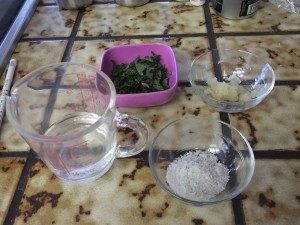
INGREDIENTS:
1 gallon whole milk, preferably fresh and organic
¼ to ½ cup Organic White Vinegar
FOR SEASONING:
1 Tablespoon Celtic Sea Salt
2 tablespoons fresh basil, sliced thinly
1-2 tablespoons minced garlic

DIRECTIONS:
Pour the milk into a large pot, and stir. Bring milk to 190 degrees (best to use a thermometer) over medium heat, stirring occasionally to prevent the milk from scorching on the bottom of the pot.
When the milk comes to temperature (small bubbles will first appear at the edges), turn off the heat. Stir vinegar into the milk, and the milk will curdle. You may need to wait 5 or 10 minutes.
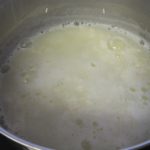
Line a sieve or colander with a cheesecloth, and pour the milk through the cloth to catch the curds. What is left in the cheesecloth is the Farmer’s Cheese. The liquid is the whey. If you want herb cheese, add the salt, basil and garlic now (or anything else you’d like to try).
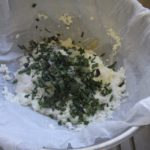
Gather the cloth around the cheese, and squeeze out as much of the whey as you can. Wrap in plastic, or place in an airtight container in the refrigerator.
You can keep the whey and drink it, and I also soak oats in the whey for my chickens
NOTE: Make sure you don’t use Ultra High Pastured Milk – it won’t work to make cheese with.
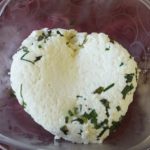
Store in the refrigerator and enjoy!
GMOs in the News
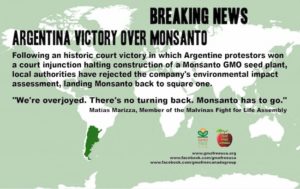
GMOs in the News
Haven’t done a news update in awhile. Isn’t it amazing, when we started Moms for Safe Food in 2009, barely anyone had heard of GMOs. But thanks to Pamm Larry and CA Prop 37, and Jeffrey Smith from the Institute of Responsible Technology and many others we are finally joining together to get GMOs labeled and out of our food supply.
Monsanto and their biotech cronies keep telling the same lies (feed the world, safe, blah, blah blah) and their starting to use what used to be the liberal press to pass along their lies – I no longer trust Mother Jones or NPR – seems like they’ve both been bought out by Biotech.
Keep it up – we are gaining momentum and WILL win this fight!
Love, Mom
Argentina stalls Monsanto corn project on environmental concerns
on 12 February 2014.
Following an historic court victory in which Argentine protestors won a court injunction halting construction of a Monsanto GMO seed plant, local authorities have rejected the company’s environmental impact assessment.
More about the protestors’ court win:
http://gmwatch.org/index.php/news/archive/2014/15246
Argentina stalls Monsanto corn project on environmental concerns – update
Shane Romig
Wall St Journal, 11 Feb 2014
http://online.wsj.com/article/BT-CO-20140211-715316.html
Monsanto Co. hit another roadblock in its plans to build a 1.5 billion peso ($192 million) corn-seed production plant in Argentina’s Cordoba province after local authorities rejected Monsanto’s environmental impact assessment.
The project has been on hold since September after clashes with protesters led the St. Louis biotech company to halt construction after completing about 30% of the work.
Monsanto’s environmental assessment didn’t “identify the relevant impacts and resulting mitigation measures,” the office of Cordoba Governor José Manuel de la Sota said in a statement late Monday.
The company said Tuesday it accepted the findings and would move to bring the project in line with the new requirements.
Monsanto “is starting from scratch with the whole process, and preparing a new environmental assessment with new standards,” Pablo Vaquero, Monsanto’s director of sustainability and corporate affairs for Latin America South, said in an interview.
It will take a month or two to analyze the air, soil, and water at the site and prepare a new assessment, Mr. Vaquero said.
A small group of environmental activists have camped out in front of the Cordoba construction site since September, blocking the road and preventing vehicles from coming in or out.
“The reality is that the environmental groups are opposed to Argentina’s farming model,” Mr. Vaquero said.
Those protesters celebrated the rejection of the environmental-impact assessment.
“We’re overjoyed,” Matías Marizza, a member of the Malvinas Fight for Life Assembly told Cordoba radio station FM Las Higueras on Tuesday. “There’s no turning back. Monsanto has to go,” he said.
Read more here:
California State Senator Introduces New GMO Labeling Bill
by Maureen Nandini Mitra – February 25, 2014
SB 1381 is a cleaner version of Prop 37, say bill proponents
California’s gearing up for round two of the GMO labeling debate. This time though the battle will be duked out in the state legislature rather than in the public arena.
Photo courtesy Senator Evans’ OfficeLast Friday, state Senator Noreen Evans, a Democrat from Santa Rosa, introduced a new bill
to label GM foods sold in California.
On Friday, state Senator Noreen Evans, a Democrat from Santa Rosa, introduced a new bill to label GM foods sold in California. SB 1381 would require food sold in state grocery stores to be labeled if it contains genetically engineered ingredients. The bill’s proponents say it is basically a cleaner, more streamlined version of Prop 37, the 2012 ballot initiative to label GMOs that was defeated at the polls.
Sponsored by a coalition of 17 environmental, consumer, food groups, and small businesses called Californians for GE Food Labeling, SB 1381 provides more protections for farmers and retailers, and places limits on potential litigation. The bill will most likely be assigned to the California senate health committee by mid-March.
“This legislation provides more clarity on who’s responsible for labeling or mislabeling,” says Rebecca Spector, West Coast director of the Center for Food Safety, the group that was lead author of the legislation. “The retailer is only responsible for labeling fresh produce at point of purchase. The bill also makes it clear that farmers are not liable unless they have intentionally misled retailers.” The Center, incidentally, had also co-authored Prop 37.
California voters rejected the ballot initiative in 2012 by a less than 3 percent margin. Spector says post-election polling showed that 21 percent of all California voters who voted against Prop. 37 reported they support labeling of GE foods but were confused about certain provisions of the initiative. Also certain provisions in Prop 37, such as banning any processed food from being labeled as natural, had alienated groups like the Natural Products Association, which should typically have been allies.
The new bill, Spector says, doesn’t include this provision. It also minimizes the risk of farmers, food manufacturers, and retailers being sued. “If a company is notified of a violation it will have a 60-day period to correct their labeling prior to a lawsuit moving forward, and there’s no fixed penalty,” Spector says.
The bill has strong support from the district Senator Evans represents, SD2, which spans over one-third of the Northern California coast from Santa Rosa to Eureka and has a huge sustainable farming community. “Those folks are very engaged,” says Teala Schaff, spokesperson for Senator Evans. Schaff says “a lot people from across the nation” too, have been calling since Friday to express support for SB 1381 which she described as “a strong consumer protection bill.”
“People want to know if their food is organic, they want to know how much salt or fat is there… this is no different. It’s not precluding these products from being available in the market,” Schaff says.
Indeed, polls have shown that 93 percent of US citizens want GM foods labeled and the push for labeling has gathering momentum lately. Last year most than half of US states introduced GMO labeling bills, though only two such bills passed in Connecticut and Maine. This year, a GMO labeling bill was just passed by Vermont’s agricultural committee. In March, Albany, NY, and Annapolis, MD, will be holding public hearing on GMO labeling bills, and voters in Oregon will likely vote on a similar initiative this fall.
Read more here:
Nine Dirty Little Secrets About GMOs
Posted: Updated:
By Robyn O’Brien
More:
Label GMOs GMO Farmed and Dangerous Monsanto Food for Thought Food News
This blog is part of a series that explores the themes and issues raised in Farmed and Dangerous, a 4-part satirical web series exploring issues related to the food system and industrial agriculture. If you’re interested in joining the conversation, please contact us at [email protected].
Transparency is sexy. Misleading people, not so much.
If you had no idea that ingredients, labeled by the EPA as pesticides, are hiding in your food, you’re not alone.
Here are nine dirty little secrets about GMOs that impact everyone from farmers to families to the financials of our economy:
1. Shh, don’t mention the food waste: “We need this technology to feed to world,” is the marketing cry of the big chemical companies. In truth, they do need this technology to feed the expectations of shareholders, but it turns out that more than one-third of the food produced in the world goes to waste. That amounts to 1.3 billion tons every year, costing us economically. In this country alone, we throw away 96 billion pounds of food every year, or 27 percent of the total amount of available food. That’s 3,000 pounds of food a second. With the United Nations on record saying that we need more than just genetically engineered food tools in the toolbox, it appears what we also need is a smarter distribution model to address this waste.
2. Forget Big Tobacco, it’s Big Razor’s playbook: Gillette will practically give away the razor to get people hooked on buying the razor blade. It’s a smart strategy for chemical companies, too. They offer the genetically engineered seed at a discount, then get farmers on the hook for buying the chemicals and suite of chemical products required to make their seeds grow. Pesticide application is up 527 million pounds since the introduction of these genetically engineered crops.
3. EPA now regulates this genetically engineered corn as a pesticide. Seriously, if you had the choice on your kitchen table or at a BBQ between a corn regulated by the EPA as a pesticide and one that wasn’t, which would you choose? No brainer. We should know which one is the pesticide and which foods it is going into.
4. Pre-treated seeds doused in chemicals: It’s called an accelerating agent, and seeds are pretreated before they are ever even put in the ground. Is it any wonder that farmers using these seeds are increasingly worried about what it is doing to the quality of their soil?
5. Pouring on the Pesticides: The latest analysis shows that genetically engineered crops have driven up overall pesticide use across the country, contributing to a 527 million pound increase in herbicide use between 1996 and 2011. And last year alone, genetically engineered crops used 20 percent more pesticides on average than non-GE crops. Who pays for that? Farmers and the people that eat them. Who benefits? The chemical companies selling the seeds engineered to withstand these increasing doses. It goes straight to the bottom line and into the bank.
6. Patent the Chemicals as a Drug: The increasingly controversial weed killer, glyphosate, has been patented an antibiotic: Who knew that the patent had been filed? Apparently the US Patent and Trademark Office. As a growing number of farmers express concern over what this chemical is doing to their soil as headlines around the world express concern over what it is doing to humans, you have to ask yourself: given the 21st century technology we have today, is it time to make this 20th century, chemically intensive operating system, obsolete?
7. Patents protect intellectual property: “The development of genetic engineering of plants in the 1980s was accompanied by a sequence of increasingly specific confirmations of the patentability of various types of life forms, provided that they met the standard patent criteria of novelty, utility and nonobviousness.” Nonobviousness is pretty discreet. So let’s say a pediatric cancer or autism group wanted to study if these crops and chemicals are contributing to the rates of cancer or autism. They’d have to go to Monsanto or the other big chemical companies for permission. It’s worth considering that just as Big Tobacco did before it, these chemical companies just might possibly be relying upon concealment of its documents from the public under intellectual property law to avoid liabilities and to evade regulation.
8. Technology Stewardship Agreements lock farmers into contracts for genetically engineered seeds. Want to break the contract? They’ll sue you. A farmer in Iowa is living testament to this happening. Once he realized that the details of that contract locked him into purchasing Monsanto’s suite of products for the life of the farm, it felt like a noose. When he wanted out, they made a point of showing the farming world that it wasn’t an option and sued.
9. Labels mean liability: Right now the companies using these genetically engineered foods want a ban on state labeling and are trying to stop a growing call for mandatory national labeling. Why? Because without labels, this “GMO Buyers Club” can claim that there is no evidence that these crops have ever caused any harm. And guess what? Without labels, they are right, there is no evidence. Labels would bring accountability, traceability and liability. It’s no wonder that the food industry is so allergic to labeling these genetically engineered ingredients in the United States. An allergic reaction to food sends someone to the ER once every three minutes.
We label the inside parts of our cars, our cell phones and our computers, so why is the chemical industry so cloaked about what goes into our food?
Can you imagine if Intel operated this way? There would be no Intel Inside and no way of knowing which parts of the operating system were functioning as promised and which parts might be detrimental to the system.
We’ve got GMO Inside our food, but no label to tell us.
The chemical industry argues that labeling would drive up food costs, and they would have to pass these added expenses on to consumers. But it doesn’t ring true, especially when you look at how American food companies label these ingredients in the products that they sell overseas and at the number of label changes for pink ribbons, Easter Bunnies or holiday packaging.
Without labels on genetically engineered ingredients, the industry can claim “no evidence of harm.” And they are right. Without labels, there is no traceability, accountability and liability. No way for these companies to be held accountable for the costs that they are externalizing onto society, our farmers, their farms and our economy.
But if the tobacco industry is any indication, it is only a matter of time before these externalized costs come back onto the financial statements of the chemical companies. Farmers and families are being impacted, and there is an antecedent here: it is Medicaid Third Party Liability (TPL) recovery obtained from “Big Tobacco,” totaling $240 billion.
As the number of food companies opting out of these ingredients grows, so too, does the number of attorneys who have children that are impacted by food allergies and other conditions.
The food awakening is on, and the companies that are opting out of genetically engineered ingredients and willing to be transparent with the consumers are capturing market share.
That is sexy to shareholders.
Hiding your ingredients and making food dirty with GMOs and lots of chemicals? Not so much.
Farmed and Dangerous was produced by Chipotle and production company Piro. Chipotle is the sponsor for the Food For Thought initiative.
Pumpkin Muffins – Gluten Free
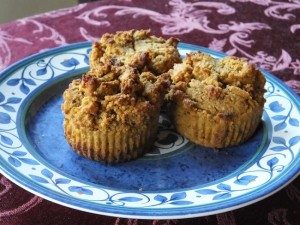
Pumpkin Muffins – Gluten Free
I took a break from using pumpkin in our baking after Thanksgiving as I baked a lot of pies. I was looking for a nice muffin to make and adapted this recipe. You could use Butternut Squash as well. They’re delicious and are even better the next day. You can freeze some for later, although they don’t last that long around here!
Makes 24 Muffins
Ingredients
Paper liners or oil or butter for greasing muffin tins
8 organic, pastured eggs
1 15 oz. can organic pumpkin puree (not pumpkin pie mix)
1 stick organic butter, melted and cooled or 1/2 cup organic coconut oil
¾ cup organic coconut flour
2 cups almond flour or meal, preferably soaked organic almonds and home ground
4 teaspoons baking powder
2 teaspoons baking soda
2 teaspoons organic cinnamon
2 teaspoons organic pumpkin pie spice
1 – 1 1/4 cups organic sugar, or stevia or non-GMO erythritol equivalent
2 teaspoons organic vanilla extract
Instructions
Put 24 liners in muffin tins or grease with butter or oil.
Preheat oven to 350°.
Batter may be mixed by hand, with an electric mixer, or a standing mixer.
Put eggs in a large bowl and beat. Add pumpkin and blend in.
Add all other ingredients and mix well.
Taste for sweetness and add more sweetener if necessary.
Divide batter evenly between 24 muffin cups. Batter should come just about to the top of the muffin tin but under
the top of the liner.
Bake for 20-25 minutes or until muffins feel a little firm to the touch and a toothpick inserted in the center comes out clean. Muffins may be cooled and frozen in a plastic bag for about a month. Enjoy!
Happy New Year – Let’s keep it up!
Here’s a great video remembering Prop 37. We will not give up!
Happy New Year!
Mom
Our Favorite Pumpkin Pie – Gluten & Sugar Free
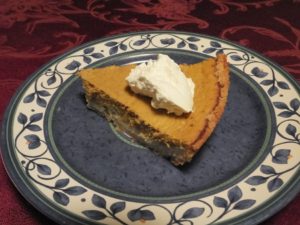
Our Favorite Pumpkin Pie – Gluten & Sugar Free
I’ve been making this pie for many years. Recently updated it to gluten free because I’ve missed having it the last few years! It’s still great!
Every fall we make pumpkin pies from fresh pumpkin. This year I grew sugar pie pumpkins in my garden. We roast the pumpkin – cut in half, take out the seeds and put face down on a baking sheet – bake at 350º until fork tender.
Once they cool, scoop out the flesh and puree it to use in pies and other baking. This recipe also works great with canned pumpkin.
If you have a food processor, you can use it to make the crusts, and then make the pie filling. All I do is wipe out any crumbs after making the crust.
For the Gluten Free Crust – you’ll need to make two of these for the filling below:
2 cups blanched almond flour
¼ tsp Celtic Salt
2 tlbs. Organic Coconut oil or Pastured Lard
1 organic/pastured egg
Put flour and salt in your food processor and pulse briefly, until mixed.
Add Coconut Oil or Lard and pulse until mixture forms a ball or looks like nice crumbs
Press into a 9-inch pie plate – fill will pumpkin puree and bake according to the directions below.
For the pies – this is enough filling for two pies:
3 cups organic pumpkin puree (you can, of course, use canned pumpkin – but roasted is SO much better)
¾ cup Swerve or equivalent. I’ve used also stevia, erythritol, honey or org. sugar
2 tsp. Pumpkin pie spice
1 tsp. Celtic Salt
4 pastured/organic eggs, slightly beaten
1 cup organic cream, raw milk or you could even use coconut milk.
Mix all ingredients, in your food processor or by hand, in the order given. Pour into two 9” pie crusts, either homemade or store bought and bake:
10 minutes at 450º, then 30 -40 minutes at 350º, or until set. (Honey will take longer, other sweeteners will be done sooner so keep an eye on it)
Makes Two – 9” pies.
Serve plain, or with whipped cream or vanilla ice cream.

